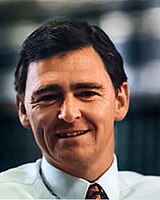| This article has problems when viewed in dark mode. Desktop readers can switch to light mode temporarily using the eyeglasses icon at the top of the page. You can help fix these problems; see the official how-to. |
| |||||||||||||||||||||||||||||||||||||||||||
All 88 seats in the Victorian Legislative Assembly All 40 seats in the Victorian Legislative Council 45 seats needed for a majority | |||||||||||||||||||||||||||||||||||||||||||
|---|---|---|---|---|---|---|---|---|---|---|---|---|---|---|---|---|---|---|---|---|---|---|---|---|---|---|---|---|---|---|---|---|---|---|---|---|---|---|---|---|---|---|---|
| |||||||||||||||||||||||||||||||||||||||||||
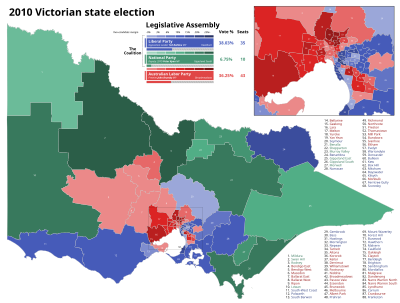 Results in each electorate. Results in each electorate. | |||||||||||||||||||||||||||||||||||||||||||
| |||||||||||||||||||||||||||||||||||||||||||
The 2010 Victorian state election, held on Saturday, 27 November 2010, was for the 57th Parliament of Victoria. The election was to elect all 88 members of the Legislative Assembly and all 40 members of the Legislative Council. The incumbent centre-left Labor Party government, led by John Brumby, was defeated by the centre-right Liberal/National Coalition opposition, led by Ted Baillieu. The election gave the Coalition a one-seat majority in both houses of parliament.
Voting is compulsory in Victoria. Elections for the Legislative Assembly use instant-runoff voting (called preferential voting in Australia) in single-member electorates (called districts). Elections for the Legislative Council use partial proportional representation, using single transferable vote (also called preferential voting) in multi-member electorates (called regions). Members of the Legislative Council are elected from eight electoral regions each returning five members, making the quota for election in each region 16.67 percent of valid votes cast in that region. The election was conducted by the Victorian Electoral Commission (VEC).
Background
See also: Results and maps of the 2006 Victorian state election and Post-election pendulum for the 2006 Victorian state electionAt the 1999 election, the Labor Party led by Steve Bracks was able to form a minority government with the parliamentary support of 3 Independents, displacing the incumbent Jeff Kennett Liberal/National Coalition government. Labor was returned with a majority government after a landslide win at the 2002 election. Labor was elected for a third term at the 2006 election with a substantial but reduced majority. Labor won 55 of the 88 seats, a decrease of 7, and 54.4% of the two-party preferred vote, a decrease of 3.4%. Brumby replaced Bracks as Labor leader and Premier of Victoria in 2007.
Political changes
The previous elections took place on Saturday, 25 November 2006. At the 2006 election, the Labor Party won 55 of the 88 seats, the Liberal Party won 23, the National Party won 9, and there was 1 Independent. Since that date a number of political changes took place.
Both Premier Bracks and Deputy Premier John Thwaites resigned on 27 July 2007.
By-elections
Between the 2006 and 2010 elections, four by-elections took place. In Bracks' seat of Williamstown and Thwaites' seat of Albert Park in 2007, former minister Andre Haermeyer's seat of Kororoit in 2008, and former minister Lynne Kosky's seat of Altona in 2010. All four seats were retained by Labor. Labor MP Craig Langdon resigned from his seat of Ivanhoe in August 2010, however the by-election writ was discharged by the Parliamentary Speaker due to the proximity of the state election coupled with the cost of holding a by-election.
Campaign
See also: Candidates of the 2010 Victorian state election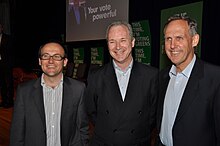
The Liberal and National Parties contested the election as a Coalition, which they had not done since the previous agreement lapsed in 2000. The Liberal Party departed from tradition and gave their preferences to Labor ahead of the Greens, thereby decreasing the chances of the Greens winning up to four inner city seats from Labor.
The Coalition launched their campaign on 14 November 2010 at the Melbourne Convention and Exhibition Centre in the electoral district of Melbourne, with the slogan: "Fix the problems. Build the future." Labor launched their campaign on 16 November 2010 in the electoral district of Bendigo East, using the slogan: "For the times ahead." The Greens ran with the slogan "This time, I'm voting Green".
Issues
The Coalition campaigned heavily against the Brumby Government's new Myki ticketing system, which had been delivered at triple the projected cost and years behind schedule, as well as its construction of an expensive desalination plant that many claimed was unnecessary. Other issues included health, education, and law and order. Ted Baillieu promised to restore the budget to surplus, employ more nurses and police, make Victorian teachers the highest paid in the country, and abolish suspended sentences which were seen as out of touch with community standards.
Retiring MPs
Labor
- Peter Batchelor MLA (Thomastown)
- Bob Cameron MLA (Bendigo West)
- Carlo Carli MLA (Brunswick)
- Judy Maddigan MLA (Essendon)
- Karen Overington MLA (Ballarat West)
- George Seitz MLA (Keilor)
Liberal
- Helen Shardey MLA (Caulfield)
- John Vogels MLC (Western Victoria Region)
National
- Ken Jasper MLA (Murray Valley)
Results
Legislative Assembly
See also: Post-election pendulum for the 2010 Victorian state election See also: Results of the 2010 Victorian state election (Legislative Assembly)
Coalition
Liberal (35)
National (10)
Opposition (43)
Labor (43)
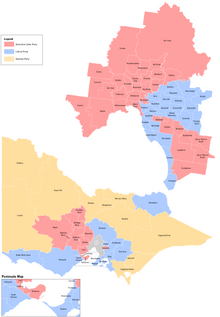
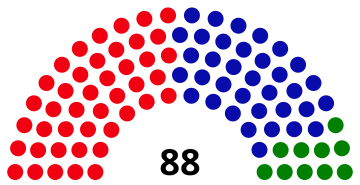 | ||||||
|---|---|---|---|---|---|---|
| Party | Votes | % | +/– | Seats | +/– | |
| Liberal | 1,203,654 | 38.03 | 35 | |||
| Labor | 1,147,348 | 36.25 | 43 | |||
| Greens | 354,697 | 11.21 | 0 | |||
| Nationals | 213,492 | 6.75 | 10 | |||
| Independents | 82,395 | 2.60 | 0 | |||
| Family First | 72,354 | 2.29 | 0 | |||
| Country Alliance | 42,938 | 1.36 | 0 | |||
| Democratic Labour | 28,176 | 0.89 | 0 | |||
| Sex Party | 17,252 | 0.55 | New | 0 | New | |
| Socialist Alliance | 1,787 | 0.06 | 0 | |||
| Christian Democrats | 636 | 0.02 | 0 | |||
| Total | 3,164,729 | 100.00 | – | 88 | – | |
| Valid votes | 3,164,729 | 95.04 | ||||
| Invalid/blank votes | 165,134 | 4.96 | ||||
| Total votes | 3,329,863 | 100.00 | – | |||
| Registered voters/turnout | 3,582,232 | 92.95 | ||||
| Two-party-preferred | ||||||
| Liberal/National | 1,633,312 | 51.58 | ||||
| Labor | 1,533,225 | 48.42 | ||||
| Total | 3,166,537 | 100.00 | – | |||
Labor suffered a swing of 5.96 percent, a larger swing than the 1992 landslide that brought the Jeff Kennett-led Coalition to power. However, much of that swing was wasted on landslide victories in the Coalition's heartland. As a result, the Coalition only just managed the 13-seat swing it needed to make Baillieu premier, netting it a bare majority of two seats.
On 29 November, with the result beyond doubt, Brumby conceded defeat. He resigned as state Labor leader the next day. The new Liberal/National government was sworn in on 2 December 2010, and former Health Minister Daniel Andrews was elected Labor leader on 3 December.
Legislative Council
See also: Results of the 2010 Victorian state election (Legislative Council) | ||||||
|---|---|---|---|---|---|---|
| Party | Votes | % | +/– | Seats | +/– | |
| Labor | 1,137,461 | 35.36 | 16 | |||
| Liberal (metropolitan) | 792,702 | 24.65 | 12 | |||
| Liberal/National (joint ticket) | 595,330 | 18.51 | – | – | ||
| Liberal (country) | 6 | |||||
| National | 3 | |||||
| Greens | 386,172 | 12.01 | 3 | |||
| Family First | 91,982 | 2.86 | 0 | |||
| Democratic Labour | 75,080 | 2.33 | 0 | |||
| Sex Party | 61,542 | 1.91 | New | 0 | New | |
| Country Alliance | 53,149 | 1.65 | 0 | |||
| Christian Democrats | 12,322 | 0.38 | 0 | |||
| Independents | 10,646 | 0.33 | 0 | |||
| Total | 3,216,386 | 100.00 | – | 40 | – | |
| Valid votes | 3,216,386 | 96.62 | ||||
| Invalid/blank votes | 112,475 | 3.38 | ||||
| Total votes | 3,328,861 | 100.00 | – | |||
| Registered voters/turnout | 3,582,232 | 92.93 | ||||
Legislative Council seats
|
In the 40-member upper house where all members are up for re-election every term, the Coalition won a majority of 21 seats, with 16 seats won by Labor and 3 won by the Greens.
Seats changing hands
| Seat | Pre-2010 | Swing | Post-2010 | ||||||
| Party | Member | Margin | Margin | Member | Party | ||||
| Bentleigh | Labor | Rob Hudson | 6.3 | -7.1 | 0.8 | Elizabeth Miller | Liberal | ||
| Burwood | Labor | Bob Stensholt | 3.7 | -9.6 | 5.9 | Graham Watt | Liberal | ||
| Carrum | Labor | Jenny Lindell | 6.7 | -8.7 | 2.0 | Donna Bauer | Liberal | ||
| Forest Hill | Labor | Kirstie Marshall | 0.8 | -3.9 | 3.2 | Neil Angus | Liberal | ||
| Frankston | Labor | Alistair Harkness | 3.2 | -5.3 | 2.1 | Geoff Shaw | Liberal | ||
| Gembrook | Labor | Tammy Lobato | 0.7 | -7.5 | 6.8 | Brad Battin | Liberal | ||
| Gippsland East | Independent | Craig Ingram | 9.1 | -21.1 | 12.0 | Tim Bull | National | ||
| Mitcham | Labor | Tony Robinson | 2.0 | -4.7 | 2.8 | Dee Ryall | Liberal | ||
| Mordialloc | Labor | Janice Munt | 3.5 | -5.6 | 2.1 | Lorraine Wreford | Liberal | ||
| Mount Waverley | Labor | Maxine Morand | 0.3 | -7.8 | 7.4 | Michael Gidley | Liberal | ||
| Prahran | Labor | Tony Lupton | 3.6 | -7.8 | 4.3 | Clem Newton-Brown | Liberal | ||
| Seymour | Labor | Ben Hardman | 6.7 | -7.9 | 1.2 | Cindy McLeish | Liberal | ||
| South Barwon | Labor | Michael Crutchfield | 4.1 | -6.2 | 3.9 | Andrew Katos | Liberal | ||
In 2006, the final Gippsland East 2PP count included Independent and Liberal, however in 2010 the final 2PP count included Independent and Nationals
Key dates
Terms are fixed at four years. Elections occur in line with the fixed term provisions laid out in the Electoral Act 2002.
Key dates for the election were:
- 2 November: Dissolution of Parliament and lodgement of election writs
- 9 November: Close of rolls
- 11 November: Close of nominations for party candidates
- 12 November: Close of nominations for independents
- 15 November: Early voting commences
- 25 November: Close of postal voting
- 26 November: Early voting closes
- 27 November: Election day (polls open 8am to 6pm)
Polling
Polling conducted by Newspoll and published in The Australian is performed via random telephone number selection in city and country areas. Sampling sizes usually consist of over 1000 electors, with the declared margin of error at ±3 percent.
| Labor Brumby |
Liberal Baillieu | |
|---|---|---|
| 2010 election | – | – |
| 23 – 25 Nov 2010 | 48% | 38% |
| 9 – 11 Nov 2010 | 50% | 36% |
| Sep – Oct 2010 | 49% | 31% |
| Jul – Aug 2010 | 52% | 27% |
| May – Jun 2010 | 47% | 31% |
| Mar – Apr 2010 | 49% | 29% |
| Jan – Feb 2010 | 51% | 29% |
| Nov – Dec 2009 | 54% | 26% |
| Sep – Oct 2009 | 52% | 27% |
| Jul – Aug 2009 | 52% | 27% |
| May – Jun 2009 | 54% | 21% |
| Jan – Feb 2009 | 54% | 22% |
| Nov – Dec 2008 | 49% | 27% |
| Sep – Oct 2008 | 45% | 27% |
| Jul – Aug 2008 | 48% | 26% |
| May – Jun 2008 | 51% | 28% |
| Mar – Apr 2008 | 49% | 23% |
| Jan – Feb 2008 | 48% | 25% |
| Nov – Dec 2007 | 51% | 22% |
| Sep – Oct 2007 | 51% | 25% |
| 2006 election | – | – |
| 22 – 23 Nov 2006 | 53% | 30% |
| Polling conducted by Newspoll and published in The Australian. Steve Bracks. ^ Remainder were "uncommitted" to either leader. | ||
| Primary vote | 2PP vote | |||||||||
|---|---|---|---|---|---|---|---|---|---|---|
| ALP | LIB | NAT | GRN | OTH | ALP | L/NP | ||||
| 2010 election | 36.3% | 38.0% | 6.7% | 11.2% | 7.8% | 48.4% | 51.6% | |||
| 23 – 25 Nov 2010 | 33% | 40% | 5% | 15% | 7% | 48.9% | 51.1% | |||
| 9 – 11 Nov 2010 | 37% | 39% | 5% | 14% | 5% | 51% | 49% | |||
| Sep – Oct 2010 | 35% | 36% | 4% | 19% | 6% | 52% | 48% | |||
| Jul – Aug 2010 | 38% | 32% | 4% | 17% | 9% | 55% | 45% | |||
| May – Jun 2010 | 34% | 36% | 4% | 18% | 8% | 51% | 49% | |||
| Mar – Apr 2010 | 37% | 38% | 3% | 14% | 8% | 52% | 48% | |||
| Jan – Feb 2010 | 39% | 36% | 3% | 14% | 8% | 54% | 46% | |||
| Nov – Dec 2009 | 41% | 32% | 3% | 14% | 10% | 57% | 43% | |||
| Sep – Oct 2009 | 43% | 32% | 3% | 15% | 7% | 57% | 43% | |||
| Jul – Aug 2009 | 43% | 35% | 2% | 12% | 8% | 56% | 44% | |||
| May – Jun 2009 | 42% | 34% | 3% | 14% | 7% | 56% | 44% | |||
| Jan – Feb 2009 | 46% | 31% | 2% | 15% | 6% | 60% | 40% | |||
| Nov – Dec 2008 | 45% | 34% | 3% | 13% | 5% | 57% | 43% | |||
| Sep – Oct 2008 | 37% | 37% | 4% | 15% | 7% | 51% | 49% | |||
| Jul – Aug 2008 | 41% | 34% | 4% | 12% | 9% | 54% | 46% | |||
| May – Jun 2008 | 41% | 35% | 3% | 14% | 7% | 55% | 45% | |||
| Mar – Apr 2008 | 44% | 33% | 3% | 12% | 8% | 58% | 42% | |||
| Jan – Feb 2008 | 43% | 34% | 3% | 12% | 8% | 56% | 44% | |||
| Nov – Dec 2007 | 51% | 31% | 3% | 9% | 6% | 60% | 40% | |||
| Sep – Oct 2007 | 49% | 36% | 4% | 6% | 5% | 56% | 44% | |||
| 2006 election | 43.1% | 34.4% | 5.2% | 10.0% | 7.3% | 54.4% | 45.6% | |||
| 22 – 23 Nov 2006 | 45% | 32% | 5% | 9% | 9% | 56% | 44% | |||
| Polling conducted by Newspoll and published in The Australian. | ||||||||||
Sky News exit polls in marginal seats recorded a Coalition 54-46 Labor result.
Newspaper endorsements
| Dailies | Sundays | |||||
|---|---|---|---|---|---|---|
| Newspaper | Endorsement | Newspaper | Endorsement | |||
| The Age | Labor | The Sunday Age | Labor | |||
| The Australian | Labor | The Weekend Australian | ||||
| The Australian Financial Review | Labor | |||||
| Herald Sun | Labor | Sunday Herald Sun | Labor | |||
References
- Speaker decides against Ivanhoe by-election, ABC News, 14 September 2010.
- Best, Catherine (11 February 2008). "Coalition reunites in Victoria". The Sydney Morning Herald. Retrieved 14 March 2010.
- "Greens still hopeful of winning seats". Abc.net.au. 2 October 1980. Retrieved 1 February 2012.
- Staff Writers (10 June 2015). "Myki system a failure, urgent action needed". GovNews. Retrieved 27 February 2020.
- "Operational Effectiveness of the myki Ticketing System" (PDF).
- Austin, Paul (16 December 2010). "The figures point to electoral wilderness for Victorian Labor". The Sydney Morning Herald. Fairfax Media. Retrieved 2 September 2011.
- "Baillieu sworn in as Premier". Abc.net.au. Retrieved 1 February 2012.
- 5 Minutes 10 Minutes. "Daniel Andrews new Victorian Labor leader". Theaustralian.com.au. Retrieved 1 February 2012.
{{cite web}}: CS1 maint: numeric names: authors list (link) - "Upper house summary". ABC. Retrieved 1 February 2012.
- "Coalition wins Upper House majority". Australian Broadcasting Corporation. 14 December 2010.
- "Section 63, Electoral Act 2002". Retrieved 6 September 2010.
- "2010 Victorian state election information: VEC". Vec.vic.gov.au. 20 August 2010. Archived from the original on 29 October 2010. Retrieved 28 November 2010.
- "'Swing is on' as voters turn against Labor: ABC News 27 November 2010". Abc.net.au. Retrieved 28 November 2010.
- "Leaders have delivered a choice between clear alternatives". Melbourne: The Age. 26 November 2010. Retrieved 27 November 2010.
- "Labor? Liberal? What difference would it make?". Melbourne: The Sunday Age. 21 November 2010. Retrieved 27 November 2010.
- "The compelling case for a vote against complacency". The Australian. 26 November 2010. Retrieved 27 November 2010.
- "Brumby earns another term". The Australian Financial Review. 26 November 2010. Retrieved 27 November 2010.
- "A tight contest between clones". Herald Sun. 26 November 2010. Retrieved 27 November 2010.
- "Victoria deserves strong leadership from next state government". Sunday Herald Sun. 21 November 2010. Retrieved 27 November 2010.
| Government of Victoria | ||
|---|---|---|
| Executive |  | |
| Legislative | ||
| Judicial | ||
| Elections | ||
| Political parties | ||

